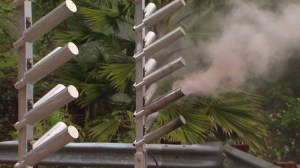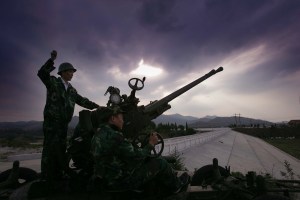Despite predictions of an El Niño deluge, Southern California still needs every drop of precipitation it can get as the state’s five-year drought continues. One solution, Los Angeles County officials hope, is a mysterious weather-modification technology: cloud-seeding.

When conditions are right, the injection of tiny ice nuclei into rain clouds can increase precipitation up to 15 percent, according to the county’s Department of Public Works. Water vapor freezes to the tiny particles, which then fall to the ground as rain.
“We’re giving Mother Nature a hand,” said department spokesman Kerjon Lee.
The technology has been used since the 1940s, according to Utah-based North American Weather Consultants, which is being contracted by L.A. County for the work locally.
In past, cloud-seeding has produced an average of an additional 1.5 billion gallons of stormwater annually, creating enough drinking water for about 36,000 local residents, the county said.
That captured stormwater from cloud-seeding is worth about $3.2 million per year — the amount it would cost to buy equivalent supply from the giant Metropolitan Water District of Southern California. The new cloud-seeding program is expected to cost $550,000 per year, making the water that’s produced a comparative bargain.

The county’s past cloud-seeding program was jettisoned in 2009 but was revived by the Board of Supervisors last fall in response to Gov. Jerry Brown’s declaration of emergency over California’s extreme drought. As of March 1, the state’s snowpack was at 83 percent of average for that date, making water officials concerned that the predicted “Godzilla El Niño” wouldn’t have the hoped-for drought-reversing effect.
In L.A. County, clouds were seeded on Monday or the first time since 2002, City News Service reported.
On Friday, officials took advantage of conditions in an expected rainstorm to seed clouds over the San Gabriel Mountains, working at the Kinneloa West debris basin above Pasadena, near Eaton Canyon.
A county contractor has up to 10 land-based silver iodide generators on county-owned land near reservoirs from Pacoima to Duarte. The generators shoot into the mountains, targeting the Pacoima Wash, Tujunga Wash and San Gabriel River watersheds.

Conditions have to be just right, however, and operators often don’t know if they’ll activate the program until the last minute, Lee said.
The manually operated cloud-seeing generators use a solution of silver iodide, acetone, and sodium iodide, while remote-operated generators use ammonium perchlorate, zinc powder, aluminum powder, silver iodide, copper iodide and ammonium iodide, according to the county.
Acetone is considered a hazardous material, but a Department of Public Works questionnaire on cloud-seeding stated “it will be used, disposed, and transported in such a way that there will be no significant hazard to the public and environment.”















